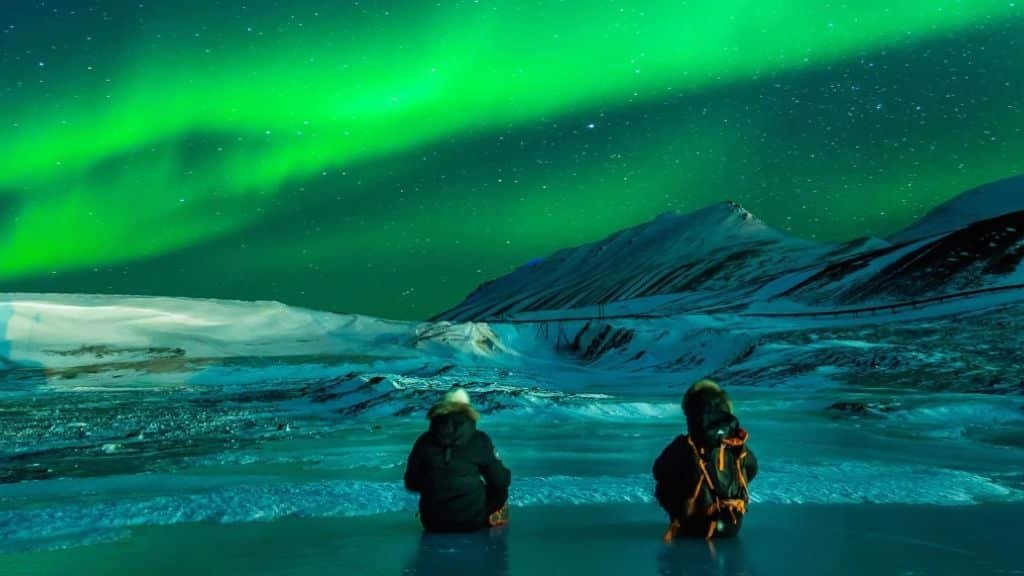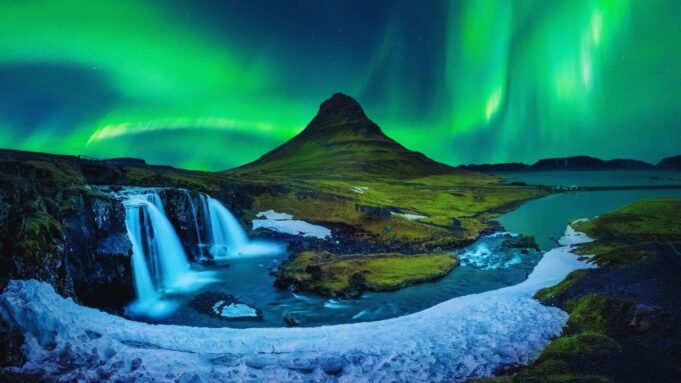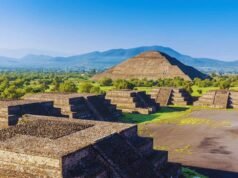Seeing the Iceland Northern Lights, or Aurora Borealis, is high on many travelers’ bucket lists—and there’s no better place to witness this natural spectacle than Iceland. With its wide-open skies, minimal light pollution, and dramatic landscapes, Iceland provides one of the most reliable and mesmerizing backdrops for aurora viewing in the world.
Whether you’re planning your first trip or returning for another shot at nature’s greatest light show, this guide covers everything you need to know to maximize your chances of seeing the Iceland Northern Lights.
What Are the Iceland Northern Lights?
The Iceland Northern Lights are caused by charged solar particles colliding with gases in Earth’s atmosphere, creating waves of glowing light that dance across the night sky. In Iceland, these displays typically appear in hues of green, though pinks, purples, and even reds can occasionally be seen during strong geomagnetic storms.
Beyond science, the Northern Lights have deep cultural significance in Nordic countries. In ancient Icelandic folklore, they were thought to be spirits, omens, or even reflections of the Valkyries guiding fallen warriors. Today, they’re a reminder of the deep connection between nature, legend, and wonder in Icelandic culture.
Best Time to Visit the Northern Lights Iceland
The best time to see the Northern Lights in Iceland is between late August and mid-April, when the nights are long and dark enough to contrast with the glowing auroras. The peak months—when weather conditions and solar activity often align—are September, October, February, and March.
Keep in mind that you’ll need clear skies, little or no moonlight, and an area far from artificial lighting to improve your visibility. Auroras are most likely to appear between 9 PM and 2 AM, though they can show up earlier or later.
Related: Top 15 Things to Do in Iceland
Iceland Northern Lights Season
The best time to see the Iceland Northern Lights is from late August to mid-April, when the skies are dark enough to allow the aurora to be visible. This period covers both fall and winter months, offering long nights and often crystal-clear skies.
Key Details:
- Peak Season: September–October and February–March (ideal mix of weather and activity).
- Nighttime Hours: The longer the night, the better your chances—December offers the longest nights.
- Best Viewing Time: Between 9 PM and 2 AM, though auroras can appear earlier or later.
- Weather Tip: Clear skies are essential—cloudy conditions can completely block aurora visibility.
Traveling during the Northern Lights season also means you can experience Iceland’s winter landscapes, frozen waterfalls, and snow-covered volcanoes, adding to the overall magic of your trip.
Top Places to See the Iceland Northern Lights

While the Northern Lights can be spotted all over the country, some locations are especially known for their low light pollution and dramatic landscapes:
Þingvellir National Park
A UNESCO World Heritage Site and a key stop on the Golden Circle, Þingvellir National Park is not only geologically significant—marking the rift between the North American and Eurasian tectonic plates—but also a fantastic spot for Northern Lights viewing.
It’s only about 45 minutes from Reykjavik, making it highly accessible for night trips. The park’s wide open spaces, low light pollution, and reflective lakes provide perfect conditions for photographing the aurora dancing over dramatic landscapes. Plus, its historical and natural beauty makes it worth visiting even during the day.
Snæfellsnes Peninsula
Often called “Iceland in Miniature,” the Snæfellsnes Peninsula is a dream destination for aurora hunters seeking variety. From black sand beaches and volcanic craters to lava fields and waterfalls, this region offers some of the most photogenic foregrounds for Northern Lights displays.
The iconic Kirkjufell Mountain, especially, is a favorite among photographers hoping to capture the aurora reflected in nearby waters. With fewer tourists than the Golden Circle and Reykjavik, Snæfellsnes also offers a more peaceful, uninterrupted viewing experience.
Jökulsárlón Glacier Lagoon
Located in southeast Iceland, Jökulsárlón Glacier Lagoon offers one of the most surreal settings to watch the Northern Lights. Massive blue and white icebergs float silently across the lagoon, and when the aurora lights up the sky above, the scene becomes magical.
Just a short walk away is Diamond Beach, where ice chunks glisten on black volcanic sand—another ethereal viewing location. While it’s a longer drive from Reykjavik (around 5 hours), the journey is worth it for this once-in-a-lifetime view.
Vik and the South Coast
The charming village of Vik, located along Iceland’s South Coast, is an ideal base for aurora viewing. Surrounded by dramatic coastal cliffs, black sand beaches, and nearby waterfalls like Skógafoss and Seljalandsfoss, Vik offers a range of scenic locations to enjoy the lights.
The region is less light-polluted than Reykjavik and provides excellent photographic opportunities, especially from Reynisfjara Beach or Dyrhólaey peninsula. Vik’s relatively mild winter conditions and accessible roads make it a practical choice for winter travelers.
Akureyri and North Iceland
Located just below the Arctic Circle, Akureyri, often dubbed “the Capital of the North,” offers some of the clearest skies in Iceland, making it an excellent place to see the Northern Lights. The surrounding region, including Lake Mývatn, boasts geothermal features, lava formations, and quiet landscapes that are ideal for aurora spotting.
Northern Iceland tends to experience less cloud cover during the winter, giving it a statistical edge for clear viewing nights. Plus, fewer tourists make the experience more intimate and serene.
The Westfjords
For serious aurora chasers seeking untouched wilderness and minimal light pollution, the Westfjords are a top pick. This remote and rugged region is far less visited than the south and east, offering solitude, dramatic cliffs, fjords, and authentic Icelandic charm.
In winter, the Westfjords can be challenging to reach due to snow-covered roads, but for those who make the trek, the Northern Lights here feel even more special—often uninterrupted by tour groups or traffic. Places like Ísafjörður and Rauðasandur beach provide incredible settings for night sky gazing.
Reykjavik
While Reykjavik is Iceland’s capital and most populated city, you can still catch the Northern Lights here—especially on nights of strong aurora activity. For the best views within the city, head to Grótta Lighthouse on the Seltjarnarnes Peninsula, where the light pollution is lower and the ocean offers a peaceful setting.
You can also join local tours that depart from Reykjavik, taking you to clearer skies just outside the urban area. While not ideal for viewing faint displays, Reykjavik is perfect for last-minute aurora chasers who don’t plan to venture far.
READ: Best Time to Visit Seljalandsfoss
Tips for Increasing Your Chances
- Check the aurora forecast: Websites like vedur.is provides daily aurora activity and cloud coverage maps.
- Go rural: Head away from city lights, ideally into the countryside or high elevation.
- Avoid the full moon: The brighter the night, the harder it is to see faint auroras.
- Be patient: You may wait hours, or even need multiple nights—pack snacks and warm clothes!
- Use apps: Tools like My Aurora Forecast or Aurora Alerts can help you plan each night.
Guided Iceland Northern Lights Tours
If you prefer not to navigate Iceland’s roads at night, consider joining a guided tour. Professional guides monitor forecasts and weather, improving your chances of a successful sighting. Popular types of tours include:
- Minibus or Bus Tours: Great for budget travelers.
- Super Jeep Tours: More rugged and adventurous—go off-road into remote terrain.
- Boat Tours: Offered in Reykjavik or Akureyri, these tours provide peaceful views of the water.
- Combo Tours: Combine Northern Lights hunting with other activities like glacier hiking, hot springs, or lava caves.
Tours often include photography assistance, warm beverages, and rebooking options if the lights are not visible.
Photography Tips in Iceland Northern Lights
Capturing the aurora on camera can be magical—but it takes some practice. Here’s how to get the best shots:
- Use a DSLR or mirrorless camera with manual settings.
- Tripod is essential: Long exposures require absolute stability.
- Settings: ISO 800–3200, wide aperture (f/2.8 or wider), shutter speed 5–15 seconds.
- Focus manually: Set your lens to infinity to keep stars and lights sharp.
- Smartphones: Use night mode or aurora-specific apps; newer models can perform surprisingly well with long exposure apps.
Dress warmly and protect your gear from condensation or snow.
Read More: 10 Best Things to Do in Vik, Iceland
What If You Don’t See Them?
Even with careful planning, nature doesn’t always cooperate. Cloudy skies, low solar activity, or timing misalignment can mean you miss out. But don’t worry—Iceland is full of unforgettable experiences. Use aurora-free nights to:
- Visit Reykjavik’s museums, cafes, or live music venues.
- Soak in geothermal spas like the Sky Lagoon or Secret Lagoon.
- Enjoy a local meal and taste Icelandic cuisine.
- Chase waterfalls, explore caves, or take a scenic drive in the daylight.
The Northern Lights are a bonus—not the only reason to fall in love with Iceland.
Iceland Northern Lights Forecast
To successfully see the aurora, it’s crucial to monitor both aurora activity and weather conditions. Iceland offers real-time Northern Lights forecasts that help travelers plan their evenings.
Best Forecast Resources:
- Vedur.is – Iceland’s official meteorological site. It provides:
- Cloud cover maps
- Aurora activity level (0–9 scale)
- Moon phase and visibility
- Aurora Apps:
- My Aurora Forecast
- Aurora Alerts Northern Lights
- Hello Aurora (Iceland-specific)
Pro Tips:
- Look for a forecast rating of KP 4 or higher for stronger activity.
- Seek out dark, rural areas on nights with low or no cloud cover.
- Keep an eye on the solar wind speed and interplanetary magnetic field (IMF) direction for more accurate predictions.
Check forecasts hourly and be flexible with your evening plans—it’s often worth the wait.
Read Also: Arctic Adventures Iceland
Iceland Northern Lights Hotel
Choosing the right hotel can significantly improve your chances of seeing the Northern Lights—especially if you stay somewhere away from city lights and with aurora-focused amenities.
Top Northern Lights Hotels in Iceland:
- Hotel Rangá (South Iceland)
A luxury countryside retreat known for its aurora wake-up calls, stargazing observatory, and prime location away from light pollution. - Ion Adventure Hotel (Þingvellir area)
A stylish eco-hotel with modern design and floor-to-ceiling windows, offering incredible aurora views near the Golden Circle. - Fosshotel Glacier Lagoon (near Jökulsárlón)
Perfectly situated between a glacier and the sea, this hotel provides great access to quiet skies and dramatic backdrops. - Hótel Búðir (Snæfellsnes Peninsula)
A romantic hotel with ocean and mountain views, ideal for a peaceful Northern Lights stay.
Tips for Aurora-Friendly Stays:
- Look for hotels that offer aurora wake-up calls so you don’t miss a sudden appearance.
- Choose rural accommodations with minimal light pollution.
- Confirm that your hotel has clear sky visibility and good proximity to open spaces.
Conclusion
Chasing the Northern Lights in Iceland is one of the most awe-inspiring travel adventures you can have. While patience and timing are key, Iceland offers some of the best conditions on Earth to witness this celestial show.
Whether you spot a flickering green glow above Þingvellir or a full sky explosion over a glacial lagoon, the moment will stay with you forever. And even if the aurora doesn’t appear, you’ll find that Iceland’s natural beauty, rich culture, and warm spirit more than make up for it.
To Know More: Iceland Volcano Eruptions
Frequently Asked Questions (FAQs) about Iceland Northern Lights
Curious about seeing the Northern Lights in Iceland? This FAQ section answers the most common questions travelers have—from the best viewing times and locations to helpful tips on tours, photography, and weather conditions. Here’s everything you need to know.
When is the best time to see the Northern Lights in Iceland?
The Northern Lights are visible in Iceland from late August to mid-April, with peak viewing months being September, October, February, and March. These months offer longer nights and favorable weather conditions. The best time of night is typically between 9 PM and 2 AM, when aurora activity is highest.
Can I see the Northern Lights in Reykjavik?
Yes, it is possible to see the Northern Lights in Reykjavik, especially on nights with strong aurora activity. However, city lights can diminish visibility. For better chances, head to darker spots like Grótta Lighthouse or take a short drive out of the city.
What conditions are best for viewing the Northern Lights?
To see the aurora clearly, you need:
- Dark skies (far from city lights)
- Clear weather (no or low cloud cover)
- High solar activity (KP index 4 or above)
Using apps or websites like vedur.is helps you track real-time forecasts and cloud conditions.
Are there Northern Lights tours in Iceland?
Yes, there are many guided Northern Lights tours from Reykjavik and other major towns. These tours are led by experts who track forecasts and drive you to optimal locations. Options include bus tours, super jeep adventures, and even boat tours.
Do I need special equipment to photograph the Northern Lights?
For best results, use a DSLR or mirrorless camera with:
- A tripod
- Wide-angle lens (f/2.8 or wider)
- Manual settings (ISO 800–3200, long exposure 5–15 seconds)
Newer smartphones can also capture the aurora with long exposure modes or night photography apps.
What should I wear when going aurora hunting?
Dress warmly, especially in winter. Layer up with:
- Thermal base layers
- Insulated jackets
- Waterproof outerwear
- Wool socks, gloves, a hat, and a scarf
Standing outside for extended periods requires good protection from Iceland’s cold and windy weather.
Is seeing the Northern Lights guaranteed?
No, the Northern Lights are a natural phenomenon and can be unpredictable. Even during peak season, cloud cover, low solar activity, or poor timing can affect visibility. To increase your chances, plan to stay several nights and stay flexible with your schedule.
















[…] Related: Iceland Northern Lights […]
Comments are closed.